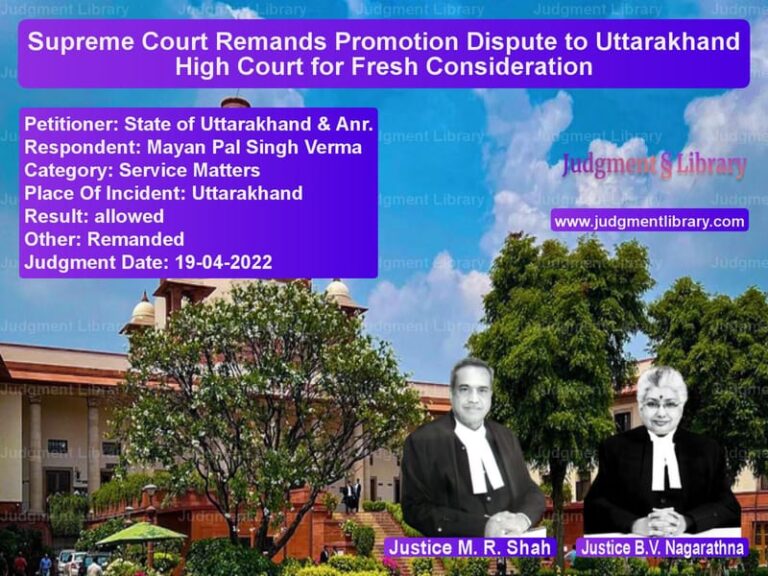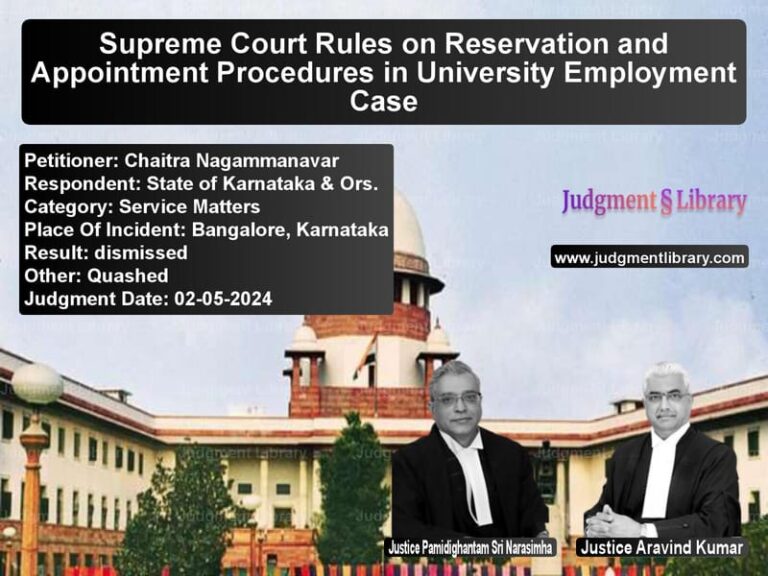Murder and Robbery Conviction Upheld: Supreme Court Ruling on Circumstantial Evidence
The case of Ramesh Dasu Chauhan & Anr. v. The State of Maharashtra is a significant legal precedent in criminal jurisprudence regarding convictions based on circumstantial evidence. The Supreme Court upheld the life imprisonment sentence of the appellants for the murder and robbery of an elderly woman, reinforcing the principles of evidence evaluation in such cases.
Background of the Case
The case revolves around the brutal murder of Kamlesh Kumari Trivedi, a 79-year-old woman, at her residence in Rajnigandha Apartments, Nagpur. On August 28, 2001, the victim’s granddaughter, Purnima Trivedi, returned home around 1:30 p.m. and discovered her grandmother lying dead with visible signs of strangulation. The Onida TV from the drawing room was missing, indicating a robbery.
Chronology of Events
- The deceased was alone in her house as her daughter and granddaughter had left for work and college, respectively.
- At around 11:45 a.m., a neighbor, Raisaheb Chourasiya (PW-9), observed two young men arriving on a red Hero Honda motorcycle and entering the apartment complex.
- When Purnima returned at 1:30 p.m., she found her grandmother dead and valuables missing.
- Police were informed, and the investigation began immediately.
- Later that evening, police apprehended the accused near Gupta Hotel in Hingna and recovered the stolen items, including the TV and a silver coin.
Legal Proceedings
Trial Court’s Findings
The prosecution presented its case based on circumstantial evidence, and the trial court identified three key issues:
- Whether the deceased died a homicidal death.
- Whether the accused committed the murder.
- Whether the accused robbed the deceased’s house.
Based on the evidence, the Sessions Court, Nagpur, convicted the accused under Section 302 IPC (murder) and Section 392 IPC (robbery) read with Section 34 IPC (common intention), sentencing them to life imprisonment and rigorous imprisonment for three years, respectively.
High Court’s Decision
The Bombay High Court (Nagpur Bench) upheld the trial court’s decision on April 11, 2008, rejecting the defense’s argument that the case was based solely on circumstantial evidence.
Supreme Court’s Analysis
Key Arguments by the Appellants
- No Identification Test Parade was conducted to establish the presence of the accused at the crime scene.
- The witness Raisaheb Chourasiya (PW-9) had initially stated that the suspects had covered their faces with mufflers, making identification doubtful.
- The panch witnesses for the recovery of stolen items had turned hostile.
Prosecution’s Counterarguments
- The accused were last seen near the victim’s residence.
- The stolen items were recovered from the accused.
- Medical reports confirmed that the deceased had been strangled.
- Witness testimonies, including those of Baliram Fulari (PW-3), Rani Trivedi (PW-1), and Purnima Trivedi (PW-4), were consistent.
Supreme Court’s Observations
The Court reaffirmed the principles of circumstantial evidence:
“The circumstances from which the conclusion of guilt is to be drawn must be fully established and should exclude every possible hypothesis except that of the accused’s guilt.”
The Court also referred to the landmark judgment in Sharad Birdhichand Sarda v. State of Maharashtra, which laid down five golden principles for convicting an accused based on circumstantial evidence:
- The circumstances must be fully established.
- The facts should be consistent only with the guilt of the accused.
- The circumstances should be conclusive in nature.
- They should exclude every possible hypothesis except that of the accused’s guilt.
- The chain of evidence must be complete.
Judgment of the Supreme Court
The Court ruled:
“Both the courts below have weighed the evidence to reach a definite conclusion that the appellants and the appellants alone entered the apartment of Kamlesh Kumari Trivedi and committed her murder by strangulation with a motive to commit robbery in the house.”
The appeal was dismissed, and the conviction and sentence of the accused were upheld.
Significance of the Judgment
- Strength of Circumstantial Evidence: The case demonstrates how a well-established chain of circumstantial evidence can be as compelling as direct evidence.
- Doctrine of Last Seen: The accused were last seen entering the apartment, and their failure to explain their presence contributed to their conviction.
- Relevance of Recovery of Stolen Items: The recovery of stolen items from the accused linked them to the crime.
- Judicial Approach to Identification: The absence of an identification parade was not considered fatal, as the witness had consistently identified the accused.
Conclusion
The Supreme Court’s ruling in Ramesh Dasu Chauhan v. State of Maharashtra reinforces the principles governing circumstantial evidence. The judgment underscores that a conviction can be sustained without direct eyewitness testimony if the prosecution establishes a strong chain of events linking the accused to the crime. This case serves as an essential precedent for evaluating criminal cases based on indirect evidence.
Petitioner Name: Ramesh Dasu Chauhan and Another.Respondent Name: The State of Maharashtra.Judgment By: Justice Deepak Gupta, Justice Surya Kant.Place Of Incident: Nagpur, Maharashtra.Judgment Date: 04-07-2019.
Don’t miss out on the full details! Download the complete judgment in PDF format below and gain valuable insights instantly!
Download Judgment: Ramesh Dasu Chauhan vs The State of Maharas Supreme Court of India Judgment Dated 04-07-2019.pdf
Direct Downlaod Judgment: Direct downlaod this Judgment
See all petitions in Murder Cases
See all petitions in Theft and Robbery Cases
See all petitions in Judgment by Deepak Gupta
See all petitions in Judgment by Surya Kant
See all petitions in dismissed
See all petitions in supreme court of India judgments July 2019
See all petitions in 2019 judgments
See all posts in Criminal Cases Category
See all allowed petitions in Criminal Cases Category
See all Dismissed petitions in Criminal Cases Category
See all partially allowed petitions in Criminal Cases Category







